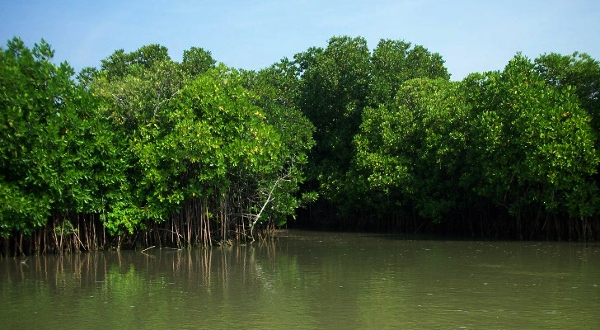A new technology developed by Indian scientists for ecological restoration is helping in revival of mangroves degraded due to rising sea levels, climate change and human intrusion in the Sunderbans in West Bengal.
Ecological restoration means reviving native ecosystem in degraded areas while maintaining diversity of original flora and fauna through regeneration but bringing down the regeneration period to 4 to 5 years. Natural regeneration takes longer time.
The restoration technology, developed by Dr Krishna Ray (West Bengal State University, Kolkata) and Dr. Sandip Kumar Basak (Sarat Centenary College, Dhaniakhali), involves plantation of native salt-tolerant grasses and a diverse set of carefully identified mangrove species in different zones of degraded mangrove patches. It also involves the use of growth-promoting bacteria.
The Sundarbans is a protected wetland under the Ramsar Convention and is also UNESCO world heritage site. Small coastal patches of mangroves are highly vulnerable and fragmentation of the ecosystem is creating barriers to species movement and dispersal.
The restoration method has been tested on a two-hectare degraded patch of mangroves in Ramganga village over the past five years and has been found more effective than monoculture of mangrove plantations as usually practiced. The project was initiated with help from the Department of Biotechnology in 2013 and is now likely to be extended to 100 acres.
The restoration process begins with stabilizing entire site of restoration by planting native salt tolerant grasses. An onsite mangrove nursery was developed to propagate mangroves for transplantation. Besides local mangroves and associate species, the nursery also grew thretened, endangered and vulnerable species. In all, 22 species of mangroves and associate plants were grown so as to maintain native diversity.
The Sundarbans is a protected wetland under the Ramsar Convention and is also UNESCO world heritage site. Small coastal patches of mangroves are highly vulnerable and fragmentation of the ecosystem is creating barriers to species movement and dispersal.
The transplantation started in November 2014, initially at a moderately degraded patch and was then extended to severely degraded zones. “Mangrove forests having high diversity are more stable than those having less species diversity and diverse multispecies mangrove forests are more resilient to sea level rise. Species for plantation in different zones which have different salinity level were selected based on their slat-tolerance levels,” explained Dr Krishna Ray, while speaking to India Science Wire.
For instance, species with low or moderate salt tolerance were planted on stabilized mudflats next to highest salt tolerant species to make the habitat species‐rich. This shore line zone was stabilized with grass species having highest mechanical strength and salt tolerance potential.
In areas that are most susceptible to erosion due to transportive force of tidal water, transplanted seedlings were protected by iron-wired cages in the root zone. This was to ensure that sediments remain confined within the cage protecting the roots till seedlings get established. In addition, plant growth promoting bacteria were used at the rhizosphere level of mangrove seedlings at the site of restoration.
“The restored site is like mini-Sundarbans which has diversity of species usually observed in pristine mangroves of Indian Sundarbans. The high species diversity of South East Asia’s mangrove communities likely makes them more resilient to sea level rise as multispecies due to interspecific facilitation and increased below-ground root production,” said Dr Ray. “As floral communities are re-established, we have found it has become favorable ecosystem also for native faunal communities like crabs, fishes, snails, butterflies and birds.”
The researchers saw a strong correlation between physiological parameters of mangrove such as levels of accumulated osmolytes and total chlorophyll concentration with factors that determine degradation (soil nutrients like ammonia nitrogen, organic carbon and plant available inorganic phosphorus, soil and surface water conductivity etc). Osmolyte are molecules required for maintaining osmotic balance in mangroves.
The group has identified degraded mangrove patches in western part of Indian Sundarbans for restoration using this technology. The research team includes Rajojit Chowdhury, Tapan Sutradhar, Momtaj Begam, Chandan Mukherjee, Kiranmoy Chatterjee, Sandip Kumar Basak and Krishna Ray. Research results on different aspects of the project have been published in journal Hydrobiologia.
India Science Wire
Source: Vigyan Prasar
Image Courtesy: Fanpop
You may also like
-
New Heat-Based Approach To Cancer Treatment Can Reduce Chemotherapy Doses
-
Scientists Take A Major Step Towards Unification Of Classical & Quantum Gravity
-
India Graphene Engineering and Innovation Centre (IGEIC) Under the Vision of Viksit Bharat@2047 Launched
-
New High-Performance Gas Sensor can Monitor Low Level Nitrogen Oxides Pollution
-
Antidepressant Drug can be Repurposed for Treating Breast Cancer
